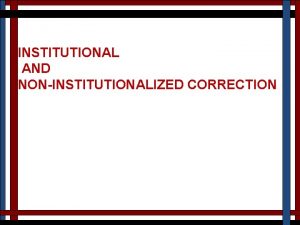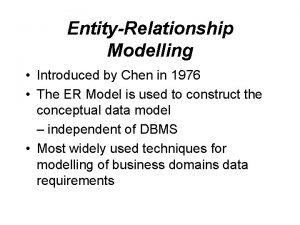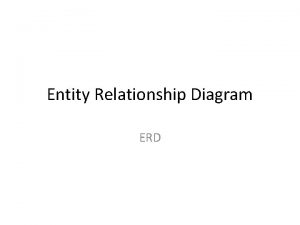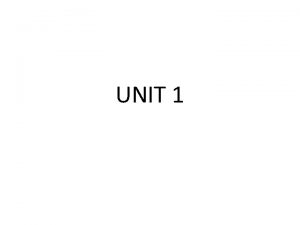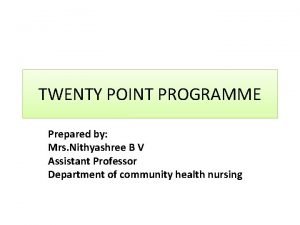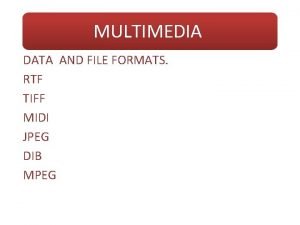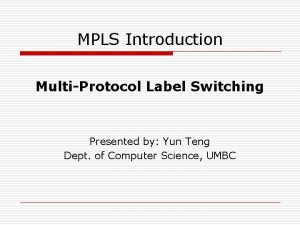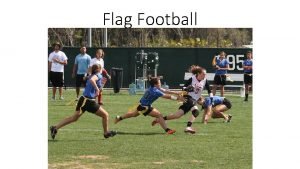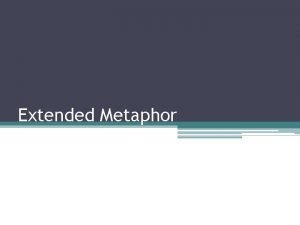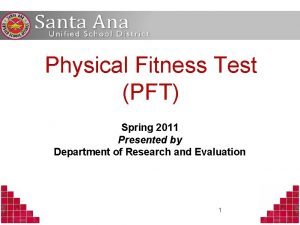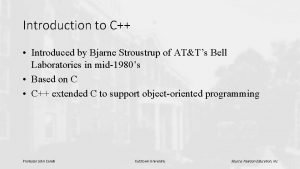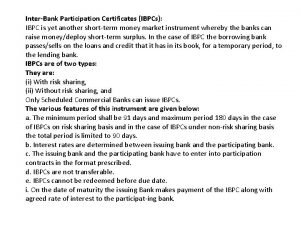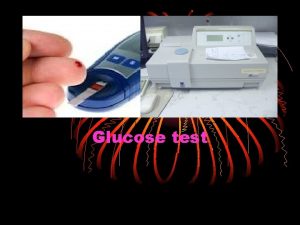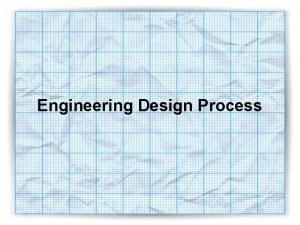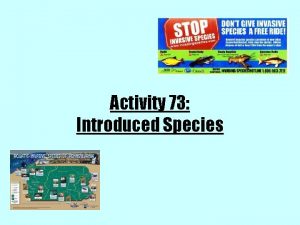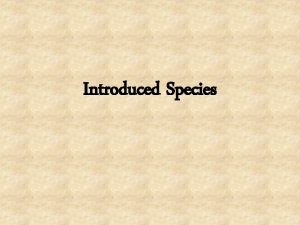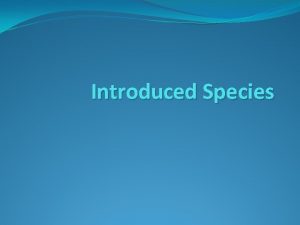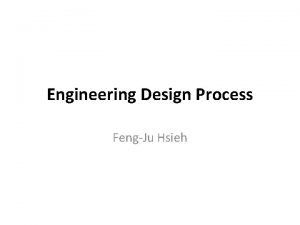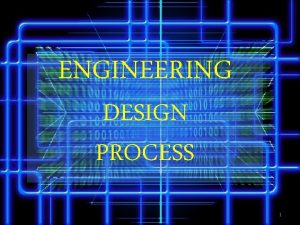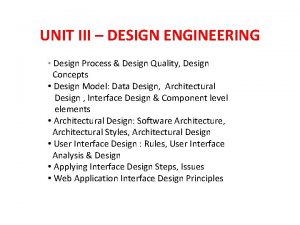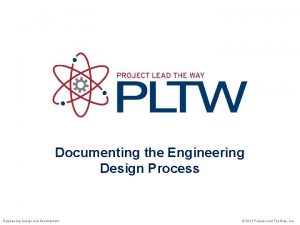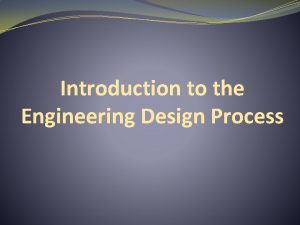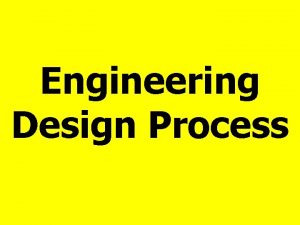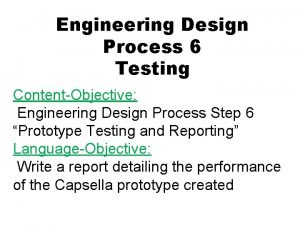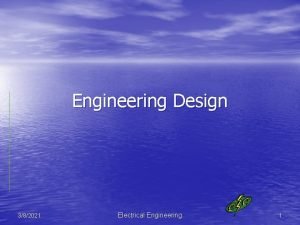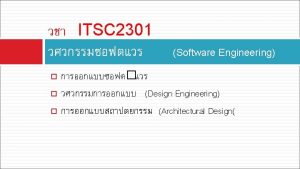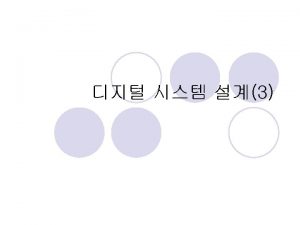The Engineering Design Process The Engineering Process Introduced



















- Slides: 19

The Engineering Design Process The Engineering Process Introduced

Come up with three important facts about the engineering design process that you learned from the video yesterday. • Engineers, scientists and inventors follow the engineering design process, when they create a solution to a problem.

What is Engineering? • Engineering deals with designing and building solutions to problems. – Engineering is essential to improving structures, machines, electronic devices, materials and systems important to society. • Scientists who use engineering to solve problems are called engineers. • Engineering is different from conducting an experiment. – The purpose of engineering is to solve a problem. The purpose of conducting an experiment is to answer a testable question. Types of Engineers

Step 1: Define the Problem • Identify the problem- a difficulty or need that must be overcome or solved • There are 3 questions to ask when defining a problem: 1. What is the problem or need? 2. Who has the problem or need? 3. Why is it important to solve the problem?

• Once you have answered these questions, you should write the problem as a statement. – [Who] needs [what] because [why]. • This is a good time to question the design criteria and constraints (see back of tape in) – If a scientist or an engineer knows the design task’s criteria and constraints there is more chance that the design solution will be successful.

Design Criteria and Constraints • • • Who is it for? (Client) What budget do you have? How long do you have to make it? What materials can you use? What scientific principles need to be applied?

• Imagine if a scientist was engineering a hover board. If they were unaware of the design criteria and constraints, they might make it out of the wrong materials; making it too expensive. Or they might not give it enough power, meaning it will not be able to lift the rider. This hover board does not even hover! CRITERIA • Must lift someone that is over 200 lb • Must cost less than $300 to produce • Must be made from light weight materials; plastic, wood, aluminum

Step 2: Develop/Design a Solution PART A: Design possible solutions • Developing solutions is the process of researching and exploring multiple possible solutions. No idea is – You should research multiple ways to too silly solve the problem. You can work individually or with a team. – Write down and draw every idea that you have related to the problem – You need to research to see what designs are already out there - you don’t want to design something that has already been created!

Step 2: Develop/Design a Solution PART B: Choose the best solution • Once you have come up with multiple ways to solve the problem, choose the best solution. – The best solution has the greatest chance of solving the problem. – Consider the cost, board benefits, risks, and feasibility when choosing the best solution. – Draw a preliminary thrust plan of what it will look like. 9

On the back of Step 2 tape in • Brainstorm any and all ideas • As a team choose which idea has the best chance of solving the problem?

Step 3: Optimizing the Design Solution PART A: Build and Test your Prototype • Follow your designs and drawing to create a prototype, or first model – Models do not necessarily have to be something you “build” it can be a blueprint of your design. – Not all models have to be to scale. – Once you have built the model, you can test it to see if it works

BIOLOGYGU It is important that the engineer tests their model. They must then modify it based on the test results. TEST #1 Prototype #1 OK, Prototype #2 has the desired thrust TEST #2 Prototype #2 12

They might follow a checklist or have a rubric which will help them determine how well they have met the design criteria and constraints of a problem. 1. 2. CRITERIA CHECKLIST YES/NO Can it move on uneven surfaces? ✔ Can it carry someone that is more than 300 X lb?

BIOLOGYGU Sometimes the engineer might have several design solutions, which have not met the criteria. However by combining the different designs they might create a new design that is better than all of its predecessors. NO GOOD! That is why you can never have too many models. They are important in finding the best design solution. 14

BIOLOGYGUY © Step 3: Optimizing the Design It is still Solution PART B: Redesign where needed • After testing your prototype, you should try to improve it so it better solves the problem or is more practical. missing something – Ask yourself: Does it meet the design criteria and design constraints? – If you are unsure, you need to see how you can improve your model. – Steps 1 -3 a may need to be repeated to improve your model. – Don’t be afraid to start from scratch! It’s ok to start over again!! I think I am going to start over! 15

On the back of Step 3 tape in • Have we solved the problem? • How can we make it better?

Rescue Robot A mother of three, Debbie Theobald knows all about coming to the rescue. Watch how Debbie and a team of engineers bring to life BEAR, a robot designed to remove people from dangerous settings and situations. http: //pbskids. org/designsquad/video/rescue-robot/

Criteria or Constraint? You must invent a new candy dispensing machine. Your machine must dispense 3 small candies at a time. You are limited to using 3 straws, 1 bowl, tape, 1 cup, 2 pipe cleaners, and 2 rubber bands. You may not use any glass, because that is very expensive. Your candy dispenser must be able to hold at least 12 grams of candy and can not cost more than $50. Constraint 3 straws • ______ Criteria must • ______ hold at least 12 grams Constraint may not • ______ use glass Criteria must • ______ dispense at least 3 candies • ______ Constraint 2 rubber bands Constraint Can not • ______ cost more than $50

Engineer or Scientist? 1. Why is the phone slowing down? Scientist 2. What can be done to make the phone operate faster? Engineer 3. What can we do to make sure that app is compatible with the new i. Phone update? Engineer 4. Why does the Snapchat app keep closing? Scientist 5. How can we improve the Snapchat app? Engineer
 Absconding probationer
Absconding probationer History of tourism 4000 bce
History of tourism 4000 bce It was introduced by chen in 1976
It was introduced by chen in 1976 Chen er model
Chen er model The dewey decimal classification system was invented in?
The dewey decimal classification system was invented in? Dental auxiliary meaning
Dental auxiliary meaning Ulugh khan
Ulugh khan Twenty point program
Twenty point program Who introduced tea to england
Who introduced tea to england What school of psychology founded by wilhelm wundt
What school of psychology founded by wilhelm wundt Rtf file format was introduced by
Rtf file format was introduced by Mpls basics introduction
Mpls basics introduction Doppler radar was introduced in_______.
Doppler radar was introduced in_______. Sole meuniere pronunciation
Sole meuniere pronunciation History of touch football
History of touch football Definition extended metaphor
Definition extended metaphor He introduced the ppft
He introduced the ppft C introduced by
C introduced by Ibpc certificate
Ibpc certificate Introduced by
Introduced by
